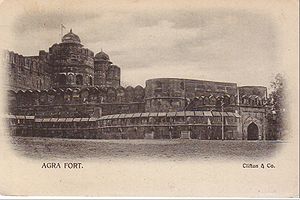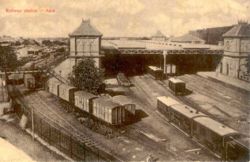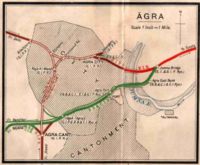Agra
| Agra | |
|---|---|

| |
| Presidency: Bengal | |
| Coordinates: | 27.179700°N 78.021400°E |
| Altitude: | 171 m (561 ft) |
| Present Day Details | |
| Place Name: | Agra |
| State/Province: | Uttar Pradesh |
| Country: | India |
| Transport links | |
| Bombay, Baroda and Central India Railway East Indian Railway Great Indian Peninsula Railway See page Agra Railways & Stations for details | |
| FibiWiki Maps | |
|---|---|
| See our interactive map of this location showing places of interest during the British period | |
| Agra |
Agra was the headquarters of Agra District in the Agra Division of United Provinces during the British period.
It is situated about 105 miles (170km) south-south-east of Delhi. As well as being the home of the Taj Mahal and the Agra Fort, Agra is an important railhead and junction. The ancient Mughal capital Fatehpur Sikri is to the south west of the city.
Contents
FIBIS Resources
History
Administration
The British took possession of Agra in 1803, and until 1829, the civil administration of the city was conducted by a Collector under the orders of the commissioners of the Ceded and Conquered Provinces. Between 1834 and 1836, Agra had its own Presidency, the Presidency of Agra, but this was abolished and the city was taken into the North-Western Provinces. The first Lieutenant-Governor installed there was Charles Metcalfe. Agra remained the seat of government for the province until 1858, when the administration was transferred to Allahabad. Ten years later, the High Court of Judicature followed.
In 1903, the North-Western Provinces were renamed the United Provinces of Agra and Oudh (United Provinces for short) and under independant Indian rule this province became Uttar Pradesh.
Military
- Battle of Agra 1803 in the 2nd Maratha War
- Retreat to Agra 1804 in the 2nd Maratha War
- Battle of Agra 1857 in the Indian Mutiny
Social
Over three quarters of a million people, mostly Indians, died during the Agra famine of 1837–38 that hit the North-Western Provinces.
Churches and missions
Anglican
- St George's, Cantonment - built 1828, consecrated 1835
- The baptism, marriage and burial records for St George’s Church (now the Cathedral) are kept at the Diocesan Office, near St Paul’s Church. [1]
- St John's Church, native church - built 1856, run by the Church Mission Society
- St Mathias's Church, Agra Fort
- St Paul's, Civil Lines - built 1855, run by the Church Mission Society
Roman Catholic
- RC Cathedral, Civil Lines - built 1848, the cathedral of the Archdiocese of Agra
- St Patrick's, Cantonment
Other denominations
- Havelock Memorial Chapel, Cantonment - run by the Baptist Mission, erected 1873 in memory of Sir Henry Havelock who, with the 13th Regiment of Foot, built a Baptist chapel in the Cantonment in 1837
- American Episcopal Methodist - by the District Courts, built 1887
Missions
- Church Mission Society, St John's College
- Baptist Mission
- Methodist Mission
Cemeteries
List of cemeteries highlights various locations.
There are three active Christian cemeteries in Agra the Roman Catholic Cemetery near Bhagwan Talkies, another one near Tota Ka Taal, and the third being the Cantonment Cemetery. Locals call it “Gora Kabristan”.
Among the inactive cemeteries, there is the Protestant cemetery, now in ruined condition, attached to St. Paul’s Church. This was the burial ground of the old Dutch factory that once stood on the land now occupied by the Church. There is also the cemetery inside the Agra Fort, in an area occupied by the Indian Army, therefore out of bounds for tourists and visitors.[2]
Online records
- See FIBIS Database for dataset of over 100 transcriptions and a few images.
- See Cemeteries for links to Inscriptions from Agra Cemeteries in Online books.
- BACSA (British Association for Cemeteries in South Asia) cemetery publications are
- Agra Cantonment Cemetery by Robin Volkers, 2001 A record of over 5,000 burials from 1806-1990s, including all existing MIs, with plot diagrams indicating the shape and location of the tombs. 697pp, 106 illustrations and plans
- Agra St Paul's Cemetery by Robin Volkers, 2007 A record of burials from 1849-1958, monuments, wall tablets and inscriptions, including those at the nearby Tot ka Tal and Sikandra cemeteries. 102pp, 22 illustrations
- Agra: Memorials of the Cathedral of the Immaculate Conception by Robin Volkers, 2012, 56pp. "This volume completes the author’s magisterial survey of the three most important cemeteries at Agra."
- See BACSA Books.
- BACSA have put the indexes to these cemetery books online and these indexes are free to browse. If an indexed name is of interest then application can be made to BACSA for details of the relevant burial inscription - charges apply for this service
Education
Colleges
- Agra College - founded in 1823 with an endowment from the East India Company
- St Peter's College - Roman Catholic institution, founded 1841 (wikipedia entry)
- St John's College - founded by the Church Mission Society in 1850 (wikipedia entry)
- Medical College - opened in 1855 for native hospital assistants
Schools
- Victoria High School - founded in 1862
- St George's High School for European children
- Convent school for girls
Orphanages
- The Roman Catholic Church ran two orphanages in Agra for European children, c 1857, St. Paul's for boys, and St. Patrick's for girls.[3]
Railways
Agra was an important rail head, served by the East Indian Railway, the Great Indian Peninsula Railway, and by both broad and metre gauge lines of the Bombay, Baroda and Central India Railway.
Stations
Agra has had a number of stations, the names of which changed over time. Many are no longer operational. Known stations are:
- Agra Cantonment (BB&CIR, GIPR) - (became Idgah) in the centre of the city, along the Fatehpur Sikri Road
- Agra City (EIR, GIPR) - in the northern part of the city
- Agra East Bank (BB&CIR, EIR) - on the opposite side of the river to the Fort
- Agra Fort (BB&CIR, EIR, GIPR) - next to the Fort
- Agra Jail - (became Bilochpura) in the North West of the city, by the District Jail
- Agra Junction - (became Jumna/Yamuna Bridge) on the right bank of the Jumna river
- Agra Road (GIPR) - (became Agra Cantt) to the south west of the cantonment, near the Sadar Bazaar
- Alumganj
- Belanganj (GIPR)
- Drummond Road
- Raja-ki-Mandi (GIPR) - in the northern part of the city
Maps
Agra and environs 1893 ancestry.com
Map of Agra 1909 Imperial Gazetteer
External links
- Agra City Imperial Gazetteer
- Agra online 1911 Encylopedia Britannica
- Diocese of Agra, Church of North India Dioceseofagra.org
- The Church Basilica of Our Lady of Grace, Sardhana The Old Palace of the Begum Sumru served as a school at times, and it was with boys from here that St Peter’s College, Agra started as an orphanage in 1846. (retrieved 31 May 2014)
- RAF Agra rafweb.org (retrieved 1 July 2014)
Historical books online
- A hand-book to the English pre-mutiny records in the government record rooms of the United Provinces of Agra and Oudh by Douglas Dewar c 1919 Archive.org
- Agra: A Gazetteer, being Volume VIII of the District Gazetteers of the United Provinces of Agra and Oudh by H R Nevill 1905 Archive.org. 2nd fileArchive.org.
- "Mofussil Stations No II - Agra" page 58 The Asiatic Journal and Monthly Miscellany, Vol 10, New Series, Jan-April 1833. Google Books
- Bengal Catholic Herald Volume X 1846 Google Books
- page 171 Male Orphans belonging to the Army will be admitted at Saint John’s College Sirdanah. (Sardhana, 22 km from Meerut). Female Orphans will be admitted at Saint Mary’s Convent Agra.
- (file) page 366 Female Orphanage at Agra
- page 404 The establishment of a Female Orphanage at Agra, “for the support and education of the relict daughters of the brave European Catholic Soldiers, who fell victims of the loyalty and courage on the field of battle, during the late glorious Campaign of the Punjab”.
- Anecdotes and Reminiscences of Service in Bengal [by A. L. M. Phillips (Alfred Lisle March Phillips) 1878] Google Books. He arrived in India in 1846 and retired 1873. At the commencement of the Indian Mutiny, he was Magistrate and Collector of the Etah district. Subsequently he was Magistrate and Collector of Agra and its district June 1857 to March 1863.
- Agra page 371 Report of the Commissioners Appointed to Inquire into the Sanitary State of the Army in India : with Abstract of Evidence, and of Reports Received from Indian Military Stations 1864 Archive.org
- A Handbook for Visitors to Agra and Its Neighborhood by H G Keene Fourth Edition, considerably enlarged and improved 1876 Archive.org. Fifth Edition 1888 Sixth edition 1899 Archive.org. The was a Seventh edition titled Keene's Handbook for Visitors to Agra by E A Duncan 1909, previously available at the Digital Library of India.
- A Handbook to Agra and the Taj, Sikandra, Fatehpur-Sikri and the Neighbourhood by E B Havell 1904 Archive.org. Second edition, revised 1912 Archive.org
- Agra page 91 India of the Rajahs by Major S E G Ponder 1940 Archive.org, Public Library of India Collection.
References
- ↑ India List post by Robin Volkers October 2010
- ↑ "Agra's Roman Catholic Cemetery and the Red Taj Mahal" 14 January 2018 The Concrete Paparazzi.
- ↑ "Catholicity in India", page 394 The Rambler, Volume 7 1857 Google Books



